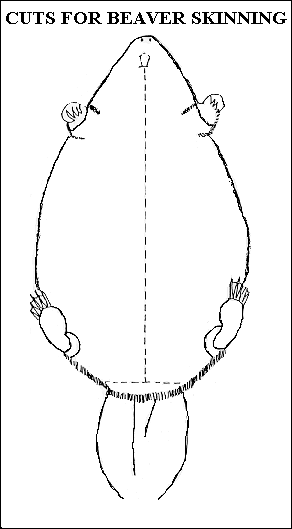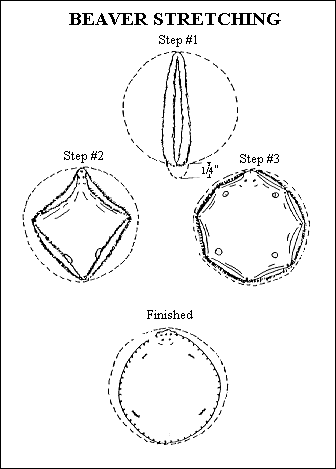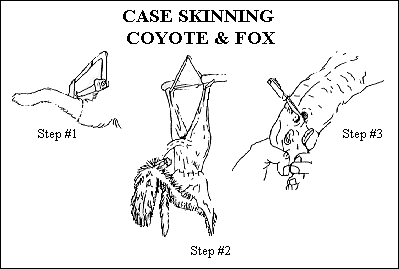
Case skinning, the first step is to make a cut entirely around the hind legs below the hock. Next, you cut up the back of the hind legs to the anal opening or the vent and cut entirely around the anus. Now work the pelt off both hind legs. Once you've worked the pelt off the hind legs you'll have the tail to contend with. To remove the tail bone make a cut from the anus up the bottom side of the tail to the end. Then peel and work the pelt free from the tail bone.
Next cut entirely around the front legs approximately 2" below the elbow and proceed to pull the hide down towards the head from the hind legs. Now we have the head area and with our knife we cut through the ear cartilage next to the skull. Use care not to cut through the pelt. Now continue pulling toward till we reach the eyes. Skin carefully around the eyes, being careful not to cut the eyelids but to leave only eyeholes in the pelt. When the skin is pulled below the eyes, you'll have to separate the pelt from the mouth section. Cut through the inside of the lips, not the fur. Keep pulling the hide till you come to the nose cartilage and cut if off and the pelt is now free.

FLESHING: The next thing is to remove all the fat, flesh and gristle from it. It is important to make sure that the pelt is free of burrs because a fleshing knife can easily cut a hole in the pelt when it hits them. Now put the pelt on a fleshing beam and with a fleshing knife scrape the hide towards the tail rotating the pelt as you go. Once the pelt has been cleaned of all loose fat and flesh any remaining grease can be wiped off the pelt with an old towel. If the pelt is dirty you can wash the pelt with soap and water, then rinse the pelt off with clean water, and wring out all excess water.

Before you put the pelt on a stretcher take the pelt by the nose and snap the pelt to release any excess water. There a two types of stretchers, wire forms and wooden stretchers. When you put the pelt on a stretcher make sure the pelt is centered on the stretcher. Do not overstretch the pelt, just pull tight enough to where the pelt is taut.
Canines & Cats. Both of these species are best if stretched on wooden stretchers, leather side out until the leather has lost some of its moisture [about 12-24 hours]. At this time remove the pelt from the stretcher and turn the pelt fur side out [carefully so as not to treat the leather]. Put the pelt back on the stretcher for final drying [about 3-5 days]. Once the pelt is dry take it off the stretcher and with a pet comb or brush work on any matted fur till the pelt has a nice fluffy shine to it.
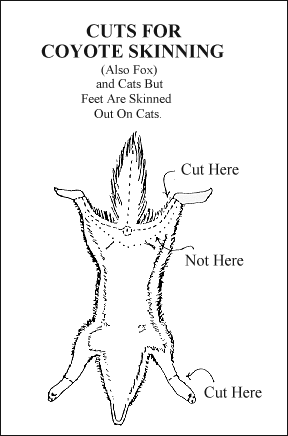
Raccoon, Muskrat, Mink, Skunk, and Badger. These pelts are stretched and finished hair side in and sold this way.
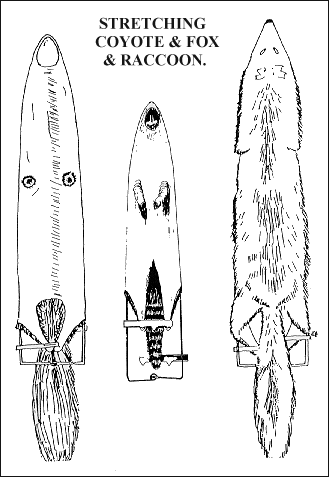
Beaver. These are skinned according to the diagram in this book. When you finish there should be four small leg holes in the pelt. You can either skin clean or skin and flesh. Beaver pelts are difficult to flesh but with practice it gets easier. Then stretch the pelt oval as in diagram. For beginning trappers it is best to go to a fur buyer and watch what he does. A fur buyer can show you how to get top dollar for a well handled pelt.
